A school trip to Iceland offers students a fantastic range of experiences. They’ll have the unforgettable opportunity to explore an active volcanic landscape that’s also being actively shaped by glaciers and ice caps. This is an opportunity to visit a country less familiar than Spain, France or Germany, and a landscape that has few equivalents in the world with as much relevance to GCSE, AS and A-level geography and science study.
Example 5-Day Itinerary for a School Group Visiting Iceland
Day 1
Your first day in Iceland begins with an opportunity to explore the Reykjanes peninsula.
- Meet your private coach on arrival at Keflavik Airport.
- Explore the Reykjanes peninsula (including the Bridge Between Continents, Gunnuhver and Krysuvik Geothermal Area).
You’ll fly to Keflavik Airport, which sits on the Reykjanes peninsula. Before heading to your accommodation, you’ll have the chance to explore the peninsula, which is home to the Reykjanes UNESCO Geopark.
The peninsula is famous for its huge lava fields and hot springs, and is the perfect ‘first taste’ of what Iceland has to offer.
You’ll cross the Bridge Between Continents. This marks the boundary between the North American and Eurasian tectonic plates, and being able to not only physically see this boundary but also cross it themselves will blow your students’ minds.
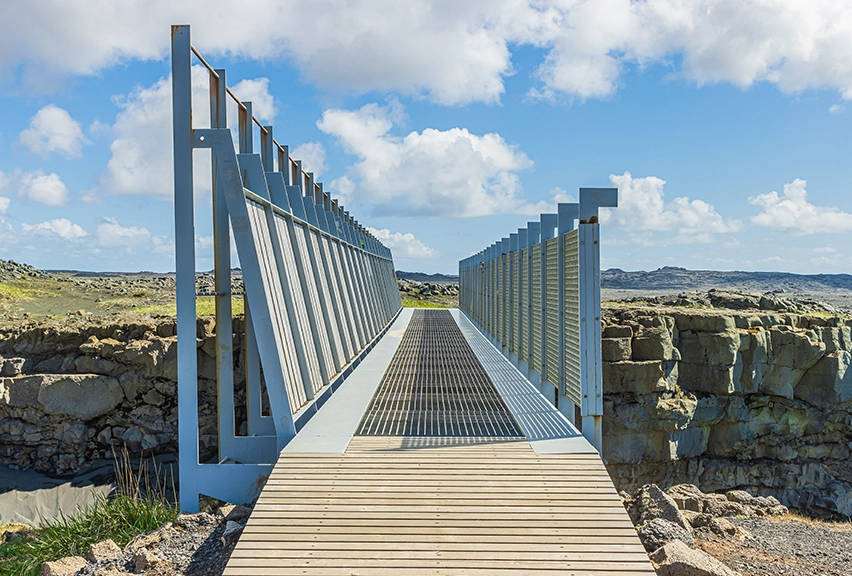
You’ll also visit Gunnuhver, where you’ll find a collection of mud pools and steam vents. Here, your students will start to get an idea of how much activity is happening beneath their feet. The Mid-Atlantic Ridge runs right through the Reykjanes peninsula, which means the area is highly volcanic (and it’s at Gunnuhver where this starts to become clear).
Finally (time and access permitting), you’ll explore the Krysuvík Geothermal Area. Here, you’ll discover more bubbling mud pools and steaming vents (and the distinctive smell of sulphur that really stays with you…).
Once your tour is finished, the coach will take you to your accommodation. Our most popular accommodation option is the Hotel Ork, which is located in Hveragerði. This small town is famous for its greenhouses (did you know, it’s the world’s northernmost producer of bananas?). These are heated throughout the year, thanks to the fact that the town sits in a highly geothermal area, allowing many different fruits, vegetables, herbs and flowers to be produced here.
Day 2
Day 2 is all about exploring the power of water, with visits to some of Iceland’s most spectacular waterfalls, as well as walking on a glacier and discovering a black sandy beach and some incredible coastal landforms.
- Discover the impressive Seljalandsfoss, Gljúfrabúi and Skógafoss waterfalls.
- Glacier walk on Sólheimajökull.
- Visit the dramatic Reynisfjara beach.
- Spend the night in the Hvolsvöllur area.
You’ll start day 2 with visits to some of the world’s most breathtakingly beautiful waterfalls – Seljalandfoss, Gljúfrabúi and Skógafoss.
At Seljalandsfoss (weather conditions permitting), your students can walk behind one of the falls along a narrow cascade, which is a truly unique experience (just make sure you pack a poncho...).
Gljúfrabúi (‘canyon dweller’ in Icelandic) is just a short stroll from Seljalandsfoss, but it’s a bit of a hidden gem. Here, you’ll find a beautiful secret waterfall surrounded by moss-covered cliffs. The water falls 40m down into a canyon carved out by glaciers and volcanic activity.
The water at both Seljalandsfoss and Gljúfrabúi begins life as snow on the infamous Eyjafjallajökull volcano (the one that caused the hugely disruptive ash cloud in 2010).
Just a heads up for visiting Gljúfrabúi – you will need to wade through a shallow stream, so everyone in the group should wear waterproof shoes (which are a bit of a must-have for a visit to Iceland anyway, to be honest). For your full list of what to pack for your trip, see our packing checklist.
At Skógafoss, you can enjoy the falls from the bottom (where the spray often creates a gorgeous rainbow), before climbing 60m (up 572 steps, so this isn’t suitable for everyone) to see the falls from the top.
Next up, you’ll head to Solheimajökull for a glacier walk. This guided walk lasts approximately 3-3.5 hours, including equipment fitting and safety briefings. This is an easy, level, steady walk onto the glacier tongue. The guides are all really informative, and your students will definitely be impressed by the experience and the scenery (plus, you’ll feel so much more connected to your surroundings than if you were simply to hop off the bus for a quick photo opp).
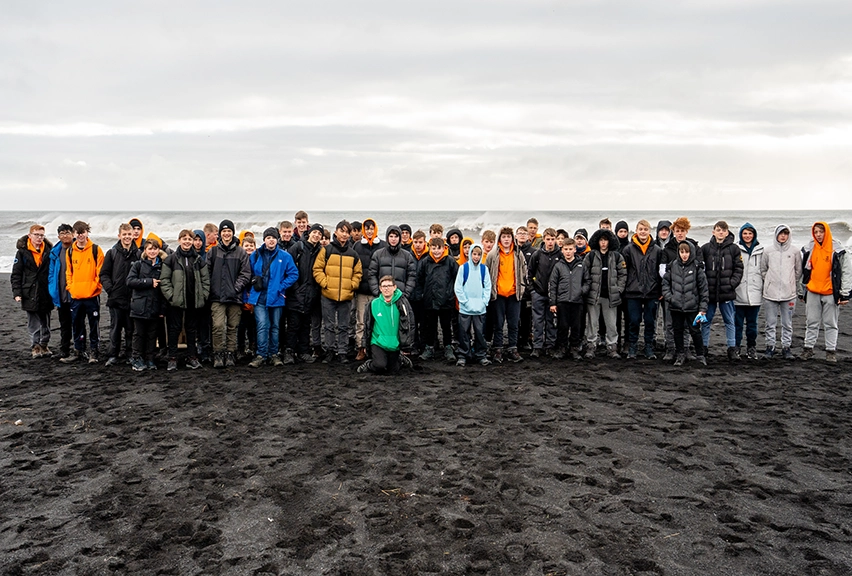
For your final stop of the day, you’ll head down to Reynisfjara beach. This beach is famous for its black sand and towering basalt columns and is a must-see for any school trip to Iceland. Just make sure your group understands that they must listen closely to your guide who will explain how dangerous the sneaker waves are here (and how to stay safe).
Looking out to sea, you’ll get a great view of the Reynisdrangar Sea Stacks and the Dyrhólaey promontory too.
You’ll spend the night in the Hvolsvöllur area (probably Hellisholar Cottages or Hotel Hellisholar), so you’ll be within easy reach of the next day’s first activity – the LAVA Centre.
Day 3
Day 3 is all about discovering the incredible geology going on beneath your feet and finding out how Icelanders have harnessed that to provide sustainable energy.
- Bring volcanoes and geology to life at the LAVA Centre.
- See another spectacular waterfall, Urriðafoss.
- Explore Iceland's new old town, Selfoss.
- See how sustainable energy is produced at Hellisheiði Geothermal Power Station.
- Take a short stroll to see Reykjadalur hot springs.
- Discover the incredible Lava Tunnel.
- Swim in a local pool after dinner
Your first stop of the day will be the LAVA Volcano and Earthquake Centre. This fantastic interactive exhibition centre brings Iceland’s volcanoes and geology to life. You’ll experience an earthquake and discover the ‘Fiery Heart of Iceland’.
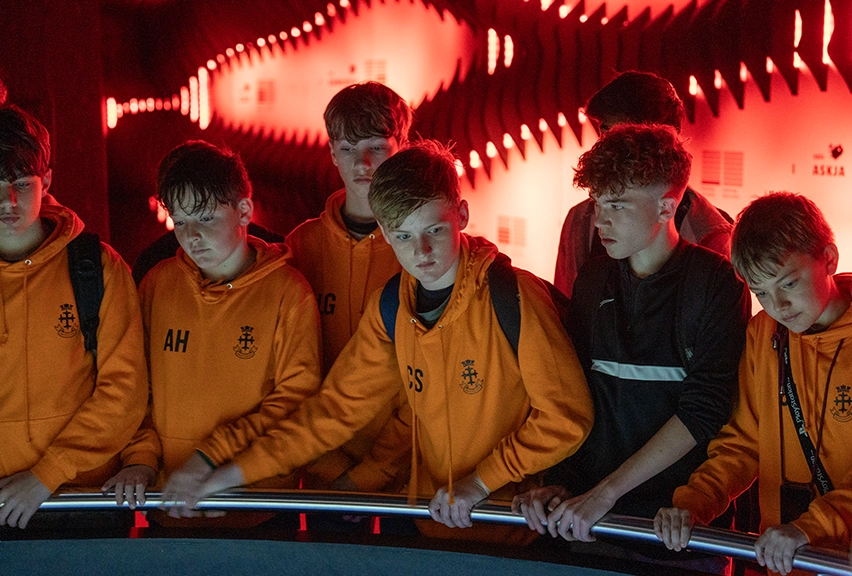
From here, you’ll drive towards Selfoss, stopping at Urriðafoss on the way. The country’s most voluminous waterfall, the way the river cascades on the edge of a lava field is truly spectacular.
Your next stop will be Selfoss - Iceland’s new old town. Here, the Icelanders have created a whole town in tribute to historic buildings that have been destroyed. It’s the first environmentally certified town centre in the world and the perfect place to stop and enjoy lunch.
From Selfoss, you’ll travel onward to Hellisheidi Geothermal Station. This is one of the largest single-site geothermal power plants in the world, and yet you’ll be really impressed by the small scale of the plant (and its minimal staffing requirements) given its huge output of power.
The station has a Geothermal Exhibition that’s ideal for groups interested in sustainability and geothermal power. This exhibition (through interactive multimedia installations, wall displays and presentations) will help your students understand how Iceland has harnessed its natural resources to produce sustainable energy. You’ll also be able to visit the power station’s turbine rooms.
Next up, you’ll visit Reykjadalur hot springs. Reykjadalur means ‘steam valley’ in Icelandic, and it’s filled with hot springs and bubbling mud pools, as well as a hot river where locals and tourists love to take a dip.
Your final stop of the day will see you head to the Lava Tunnel, where you’ll enjoy a guided visit, walking in the path of lava that flowed here over 5,000 years ago.
After this, you’ll head to your accommodation (which will be in the Selfoss or Hveragerði area), where you’ll relax over your evening meal and a dip at a local pool. It’s worth saying here that many settlements in Iceland have a local pool, so swimming tends to be a very easy and inexpensive activity (and a great way to relax after a full-on day of exploring). You’ll usually pay locally, but just let us know and we can include this in your itinerary.
If you do choose to include some swimming, you'll need to make sure everyone in your group understands how important it is that they shower before entering the pool (check out our travel etiquette guide for more on this).
Day 4
Day 4 is all about Iceland’s Golden Circle – a 190-mile circular route that encompasses many of Iceland’s most famous landmarks, including Gullfoss, Geysir Geothermal Area and Thingvellir National Park.
- See the spectacular Kerid Crater.
- Relax in the thermal waters of the Secret Lagoon.
- Explore the Geysir Geothermal Area.
- Check out the dramatic Gullfoss waterfall.
- Visit Thingvellir National Park.
- Enjoy an evening swim at Laugardalslaug Geothermal Pool.
The first stop on day 4 is Kerid Crater. This is a spectacular caldera that’s famous for its unique red-coloured volcanic rock. This, against the intense blue of the lake at the bottom of the crater, makes for a really incredible view.
Next up is (in our opinion) the most relaxing way to experience the Icelandic landscape – in one of its famous geothermal pools. The Secret Lagoon is one of the oldest natural pools in Iceland and takes advantage of the natural hot springs in the small village of Flúðir. The water’s a toasty 38-40°C throughout the year.
Your first stop on the Golden Circle Tour (once you can prise yourselves away from the Secret Lagoon, of course) is Geysir Geothermal Area. This is where you’ll find the famous Great Geysir, which has given its name to hot springs all over the world.
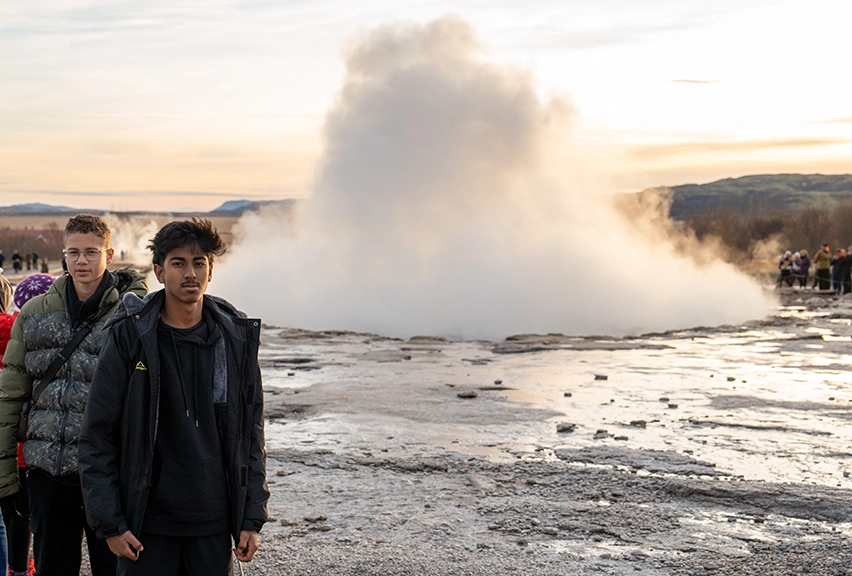
Geysir itself is currently inactive. But, don’t worry, you won’t miss out on the drama of seeing a geyser erupt, as the area is also home to the (very active) Strokkur. Every 5-10 minutes, Strokkur shoots boiling water 15-20m (and sometimes even higher) into the air. It’s a really spectacular sight (but very tricky to get a decent photo – we'd opt for a video).
There’s also a visitor centre with toilet facilities, a souvenir shop and a place to buy food and drink.
Only a few minutes’ drive from Geysir is Gullfoss (the ‘golden waterfall’). This is one of the most impressive waterfalls in Europe, where thousands of tonnes of icy water thunder majestically down double falls into a deep canyon. There’s just a short walk from the coach park to the falls along a well-laid pathway (and there are several optional routes to view the falls from different angles).
The next and most spectacular stop on the tour, Thingvellir National Park, is a remarkable geological site and the most historic site on the island. Located by Thingvallavatn (the largest lake in Iceland), the area is now a national park.
The beautiful canyon running through the park is actually the meeting point of two of the Earth’s tectonic plates. In fact, this area is part of a fissure zone running through Iceland, sitting on the tectonic plate boundaries of the Mid-Atlantic Ridge. The faults and fissures of the area bring the rifting of the Earth’s crust to life in spectacular fashion. And standing on the path running along the ridge will really help your students understand the forces involved in creating such amazing features.
It was these features and the natural landscape that persuaded the inhabitants to use this area for their first parliament in c. 930 AD and, ultimately, put it onto the World Heritage list of protected sites. So, as well as literally seeing the Earth’s crust being pulled apart here, your students will also discover how the landscape can shape the history and culture of the people that live in it.
You’ll spend the night in Reykjavik and can go for an evening swim at Laugardalslaug Geothermal Pool (if you’d like to). This is the largest pool in Iceland, with arguably the best facilities, including an Olympic-size indoor pool, an outdoor pool, four hot pots (Jacuzzi pools), a whirlpool, a steam bath, and a curling 86m water slide.
Day 5
Day 5 of your school trip to Iceland offers a last look at some of the natural wonders of this magical country before it’s time to head home.
- Visit Perlan to explore the wonders of Iceland, ice caves and the Northern Lights.
- Alternatively, spend some time exploring Reykjavik or enjoying one of the city's many exciting activities.
- Head back to the airport for your return flight.
It’s your final day in Iceland. You may have already been lucky enough to see the Northern Lights (or weather may have scuppered this) – either way, you’ll be able to discover this and more of Iceland’s incredible natural wonders at the Perlan.
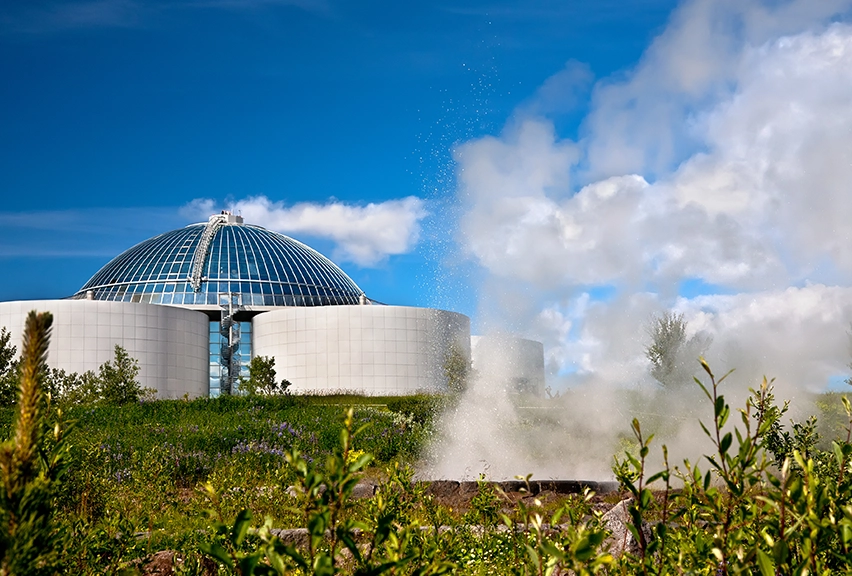
Originally built as hot water storage containers, the impressive building has a museum and an outdoor viewing deck offering panoramic views across the city. The Ice Cave and Glaciers exhibition will allow your students to explore an ice cave in complete safety (and it’s made from real snow taken from Icelandic mountains.
And the Northern Lights show means that even if you weren’t lucky enough to see them in the wild, your group can still experience the aurora borealis before leaving Iceland. An unforgettable visual experience, the show explains what causes the Northern Lights and tells ancient stories about them.
You could easily spend a good couple of hours here before you have to head back to Keflavik Airport for your flight home.
Alternatively, you might want to take some time to explore the Icelandic capital, Reykjavik.
There’s a lot to be said for taking a bit of time to explore Reykjavík. Although it’s the capital, it’s a small city that feels really safe, so it’s great for school groups. Great photo opps around the city include Hallgrimskirkja (the impressive church that’s one of the most photographed sites in the city), Rainbow Street (Skolavordustigur which, along with Laugavegur, makes up the main shopping area) and the iconic Sun Voyager.
Or you may choose to enjoy some of the fantastic activities the city has to offer, like FlyOver Iceland and the Lava Show.
And then, all too soon, it’ll be time for you to head to the airport after what we hope will have been a completely unforgettable, life-changing trip for your group.
Halsbury Team Tips
What should we visit on our trip to Iceland?
Many of the main sights for geographers are on the South Shore and Golden Circle routes. Some key visits (including waterfalls, geothermal areas, glaciers, black sand beaches and Thingvellir National Park) are pretty much always included, but there are plenty of other areas of Iceland to visit too. For example,the Jökulsárlón glacial lagoon east of Vik, the west, and the north (all of which offer different, but equally rich, experiences of Iceland).
Some groups choose to include a whale-watching experience in their trip to Iceland. Whale-watching tours run year-round, but the best time for viewing is over the summer months, from April to the end of October. At this time, the most common sightings are of minke whales and white-beaked dolphins (with the occasional humpback seen as well).
When should we visit Iceland?
The great thing about Iceland is that it really is a year-round destination. This is a country where it’s pretty common to experience four seasons in one day. In fact, Icelanders say that there’s no such thing as bad weather, just bad clothing. So, as long as you’re prepared (and layers are the key here), you’ll be absolutely fine.
Choosing when to go really depends on what experience you want to have. Winter offers a really magical, snowy landscape, while spring and summer see the country come alive (and if you want to see the famous puffins of Heimaey Island, you’ll want to visit in the summer).
If you want to see the Northern Lights, your best chances are between late September and mid-April (although this can never be guaranteed and you’ll want to stay out in the countryside where there’s less light pollution to increase your chances).
Really, each time of year offers something different (but whenever you go, you’ll still need to be prepared for any and all weather conditions).
When should we start planning our trip to Iceland?
We cannot stress the importance of planning your trip well in advance. Accommodation providers start taking bookings 2 years in advance, and the most popular options book up soon after that. That’s because, although Iceland offers some great accommodation options for schools, the size of the country means stock is very limited (and accommodation is often on the smaller side for the same reason).
Key activities and guides also get booked up very quickly, so you’ll want to secure yours as soon as possible.
Where should we stay in Iceland?
There are some fantastic accommodation options for school groups in Iceland and, depending on your itinerary, you may stay in a couple on your trip.
The Dalur Hostel in Reykjavik is a good base for smaller groups, as they have a number of 4-bedded bunk rooms with private bathrooms. It’s ideal for those who would like to have some outside space (they have a field out back and it’s next to a large public swimming pool that you can use in the evenings, for a small extra cost).
The Hotel Ork is around 45 minutes from Reykjavik and is a great base if you don’t want to stay in the city. The hotel is very large with an outdoor pool and hot tubs and, given its distance from the city, gives you a better chance of seeing the Northern Lights.
The Hellisholar Hotel Eyjafjallajökull is right on the South Shore route. The hotel has two property options, in either the hotels or the cabins. The cabins are spread over the farmland and sleep up to 6 students with a small kitchen area. These are a lovely option for older groups who like their space. The hotel is just a 2-minute walk to the main restaurant building. This option is great for Northern Lights spotting, as it’s far from any city or village lights.
The Hotel Cabin offers fantastic value for money for school groups. The hotel is well located, within walking distance of Reykjavik city centre. The hotel provides a buffet salad bar with soup and a hot meal option each evening that’s very cost-effective (so, many groups choose this option). You can also mix this with a meal out one night – the local Hamburger Factory is a good choice, as it’s just a 10-minute walk away.
Ready for your Icelandic adventure?
Hopefully, this has given you a taste of what your school trip to Iceland could look like. Just remember that we’ll tailor your trip to suit your requirements and learning objectives. So, get in touch and let’s start designing your trip today.